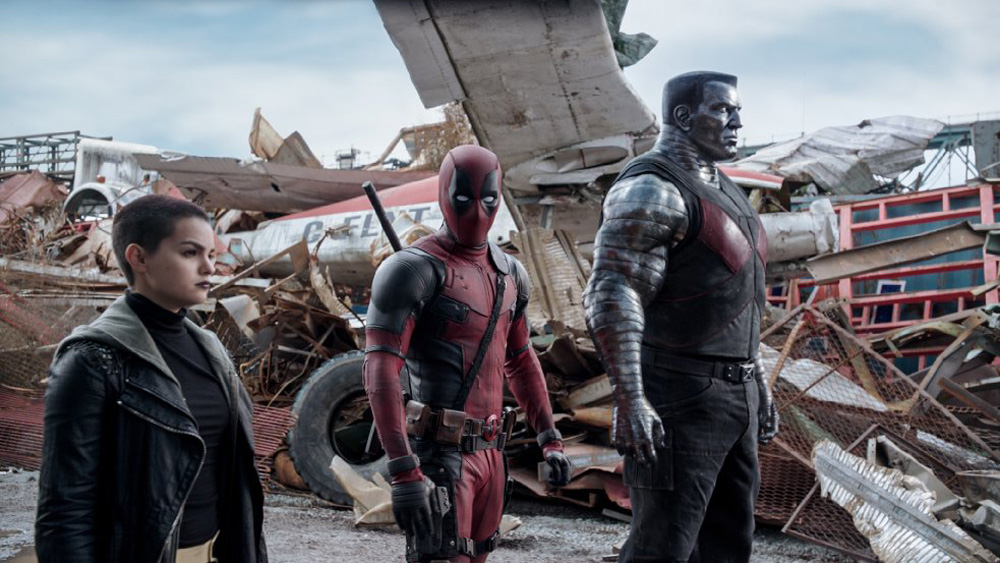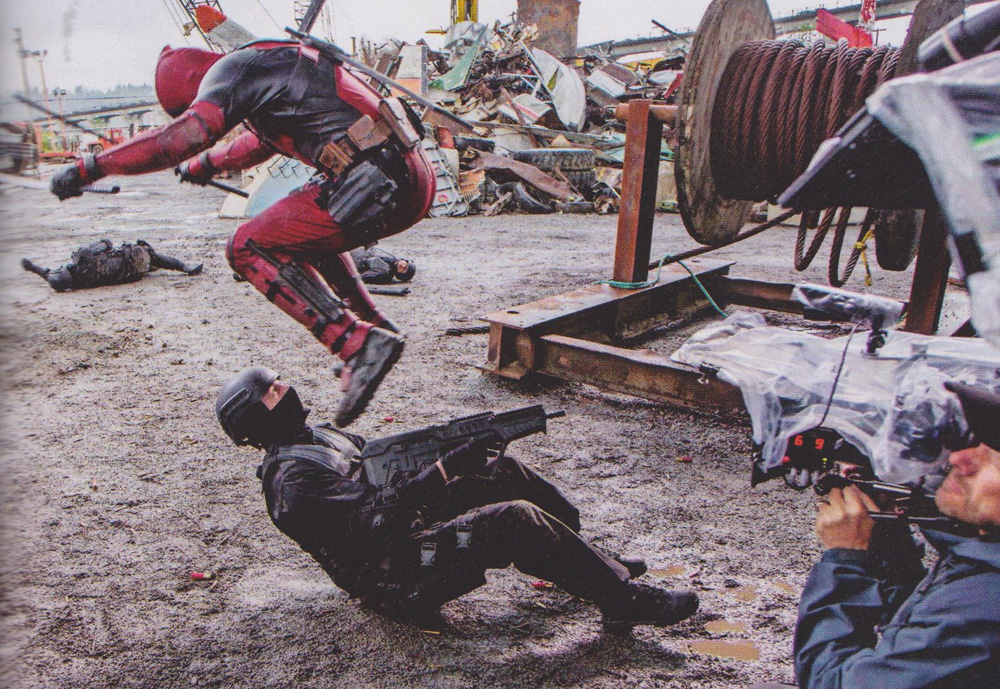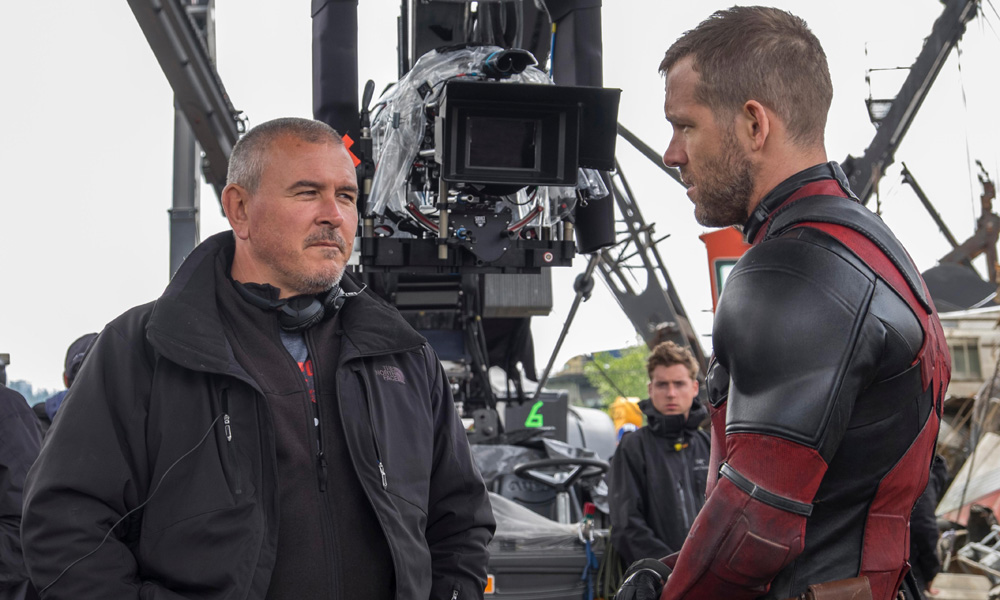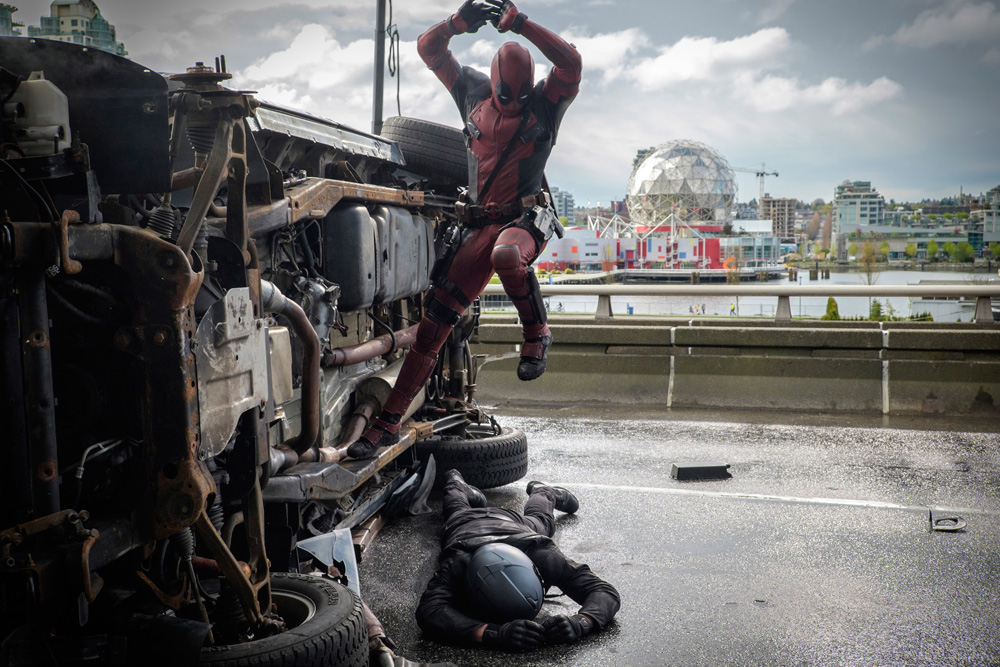DP Ken Seng and director Tim Miller shot ‘Deadpool’ to look 
like no other superhero movie, paying close attention to post,
VFX and precise on-set LUTs, and striking a chord with fans.
Capturing ‘Deadpool’ from Set to Post

Deviant Marvel film ‘Deadpool’ was director Tim Miller’s first feature film, made alongside cinematographer Ken Seng. Determining early on that they would conceive the film as something completely different to other superhero movies, Ken and Tim made production decisions leading to the final result that has struck a chord with fans and become a massive box office success.
“We wanted imagery that felt grittier and less clean and glossy than most of the superhero films out there, without being overly affected in terms of the look,” said Ken. “We approached the shoot having decided that we were going to add film grain later in the process. Texture is something I’m always striving for, whether it’s from a lens flare, slight over exposure, fogging up the blacks by backlighting the lens, or shooting with older lenses. The advanced digital cameras we use now can look too perfect. It was incredibly important that everything felt very real.”
Non-linear Story
That aesthetic was in tune with the main character, who is a less-than-charming mercenary in the earlier chapters of his story. Adopting a nonlinear story structure, the production planned to use various visual clues to distinguish different times and places, helping the audience follow the action. Ken used Super Baltar lenses and older Cooke zooms for sequences of the character’s sketchy past, often shot wide open – that is, at full aperture with a very shallow depth of field, and letting in the maximum amount of light. For contrast, Panavision Primos were used in the more recent, heroic scenes to lend more clarity, which could then be softened and given character by adding the grain.

Tim Miller is a co-founder of Blur Studios, best known perhaps for extremely life-like, charismatic animated game cinematics. His approach to filmmaking is grounded in his background in visual effects, which meant that he placed great importance on organising the shoot to assist the integration of CG elements and live action in post. This was accomplished in part with interactive lighting on the set.
Realistic Reflections
One dramatic example is a scene showing an epic car chase in and out of tunnels. To achieve the scene effectively and efficiently, the car was shot on green screen. For lighting, Ken used carefully timed, plates shot with a multicamera-array by second unit at a Detroit location. These plates were projected through 4 x 4ft WinVision LED panels, placed on the green-screen stage around the vehicle and actors during the shoot. Ken controlled the brightness of the LED panels so they would create the same reflections on the vehicle and the actors that would be seen if the car were actually passing in and out of tunnels.
The plates were then composited into the shots as backgrounds later on. While on set, the panels threw enough light onto the vehicle to allow Ken to shoot at a low aperture of 2.8 to 4.0 in most cases, without supplemental lighting.
“The car was a black SUV with an all-leather interior, so it was very reflective,” said Ken. “Everyone I talked to, even experienced filmmakers that I work with on commercials, think it’s real. When I tell them it was shot on a stage, they’re blown away, so that makes me feel like I accomplished what I set out to do.”
ARRIRAW Open Gate
He remarked that one critical factor of the shoot for this scene was using the ARRIRAW open gate recording mode, which is built into the ALEXA XT cameras he was using. “I like the operating to get a bit frenetic at times, but I’ve had directors who wanted to pull that back with in-camera image stabilisation,” he said.

To achieve both aims, the quality of the sensor and processing power of the ALEXA XT makes it possible to capture a frame that is larger than the standard 2.8K ARRIRAW format. This frame’s active size is approximately 3.4K in a 1.55:1 aspect ratio that includes, and extends beyond, the surround view area. Recording this frame requires recording in ARRIRAW on a device that will capture the whole chip. In the case of ‘Deadpool’, Ken and Tim used the Codex onboard recorder.
Ken said, “Shooting in open gate format with the Codex gave us the ability to use the 4K background plates. It also allowed us to delay image stabilisation until after the fact and to apply some subtle framing adjustments, which often came in handy due to our 7.5ft tall CG character, Colossus. We didn’t have the budget for extensive pre-vis, so it was important to have the flexibility to blow things up. That’s why it was useful to be on the XT, and not worrying about external recorders. It allowed us to be a little more run-and-gun with the action sequences. It was a nice combination of new techniques and gear with practical, old school filmmaking.”
Moody Atmosphere
Their approach to the lighting for the sequence seems elaborate but Ken believes that this approach saved the production significant time and money. “The alternative would have been to have grips and electricians up on ladders, waving flags in front of lights, trying to emulate the tunnels,” he said. “Then there’s a big fight in the car, and dimmer board cues, and syncing up with what the second unit shot. It would have taken forever, and it wouldn’t have looked as good.”
Using their method, Ken and DIT Mitchell Bax were able to review the plates from Detroit and match them with a moody, overcast atmosphere, designing simple LUTs specifically for the plate footage that would be reflected in the SUV’s glass and metal. That desaturated lighting, combined with on-set adjustments to contrast and brightness on the LED panels, helped sell the illusion.

The shoot included five weeks of exterior locations, all of which had to match Ken’s overcast look and often made generous use of negative fill for a higher contrast effect, flying 40 x 60ft black screens on construction cranes that doubled as sun shades or rain flies when the unpredictable Vancouver skies changed.
The production had control of a big elevated bridge on a major thoroughfare, but only from 5am to 2.30pm. “We just had to keep shooting, rain or shine, because once our permit expired on the bridge, we were never going to get it back,” said Ken. “When it was cloudy, I had to light with as much contrast as I possibly could, using the negative fill and by cranking up the edge lights. Whenever it was sunny, we had to back everything off and shoot. Also, because the highly reflective CG Colossus would be walking around in the chase sequence, it was important that all the plates and the whole scene were consistent from shot to shot.”
On-set Workflow
As soon as the production moved into editorial, they started pre-grading all selects to match. Although the Codex/ARRIRAW workflow results in very large files, a beneficial aspect this was that the images held a lot of latitude and room to work with. “With Tim Stipan at EFILM as our colourist, we could pull some of the contrast out of those sunnier shots, while maintaining our look. Then we were able to take the overcast, cloudy footage, punch up the contrast, and get as much as we could out of the edge lights. We were astonished that we were able to get the scene as close to matching as we did, and it meant we didn’t have to do any reshoots or additional photography, on a location that would almost be impossible to permit again.”

The production generally carried four cameras – three XTs, one of which was usually on Steadicam, and an ALEXA M – which were usually tethered with BNC HD-SDI cable. Mitchell Bax processed the Log-C signal with Blackmagic Design HDLink boxes. HDLink connects SDI video directly to most types of LCD monitor to display HDTV resolution video. In this case, Mitchell sent the signal with the appropriate LUT applied to two 23” SONY PVM-A 250 OLED monitors for on-set viewing.
Real-time LUTs
Although Ken had created a base look during pre-shoot tests, the camera team often designed a specific LUT on the shoot day. “Our base LUT was a starting point, but I would tweak it to match cameras or change the tone to suit Ken’s taste,” Mitchell said. “I was using Pomfort LiveGrade to build the LUTs in real-time, and sometimes Ken would even do the building himself on the Tangent wave panel I was carrying. I would flip control over to his side of the cart so that he could instantly re-adjust. Sometimes it was just a small luminance tweak, and other times he’d completely rebuild based on his lighting for the day.”
When shooting open gate, images were recorded at 3414 x 2198 resolution, with the frame lines set to a 2.39:1 aspect ratio with an 8% crop and 30% offset. For high speed work, the camera was switched to 16:9. As mentioned above, being able to use the image across the whole chip allowed them to make these adjustments. Mitchell would download material from the Codex Capture Drives to his onset RAID using Pomfort Silverstack, media ,anagement software for Film Production, including colour workflows and metadata libraries, that allowed him to catalogue the entire movie in one programme.
“By the end of the show, I had a large library of LUTs,” he said. “A pre-built LUT is valuable, and referencing a library of good ones can save a lot of time on-set. We were always referencing previous scenes to match colour temperature, ASA, shutter angle, frame rate and so on. Using an LUT library saves the camera department from flipping through stacks of handwritten camera reports.”
Saving Time in Post
As the main interface into his laptop, he used a Codex Capture Drive Dock feeding into a TB2 Pegasus Promise 8 TB RAID 5-disk array. The footage was then passed to Deluxe Encore in Vancouver for post.
Mitchell finds that good LUTs can also save time in post. “Ken was adamant that our image always look its best on-set. When I finally saw the movie, I was impressed by how similar it looked to what we had done on the day,” he said. “Some scenes did need more work in the DI than others to match together and really pop, but it was rewarding to watch it in the theatre and see that the colourist had either referenced our work on set, or started with those exact LUTs and made a final pass based on them. In my mind, that’s a huge time saver. By constantly managing a catalogue of on-set looks, I feel as though I gave the post production process a head start.” www.codexdigital.com
Images courtesy of Marvel Studios




